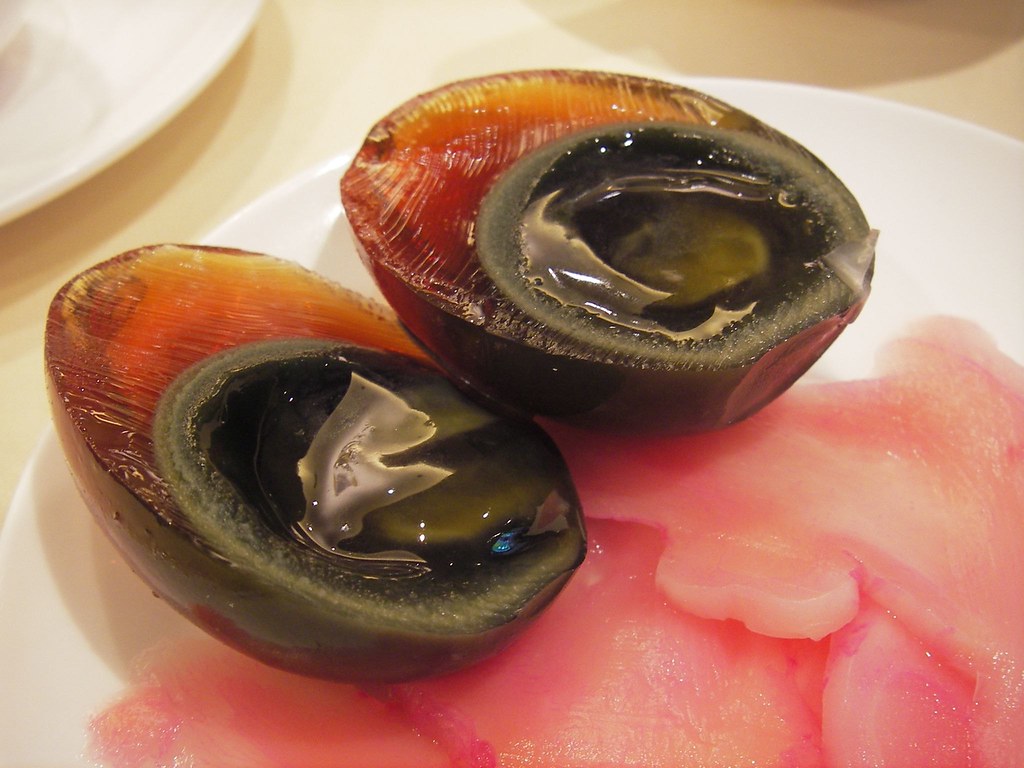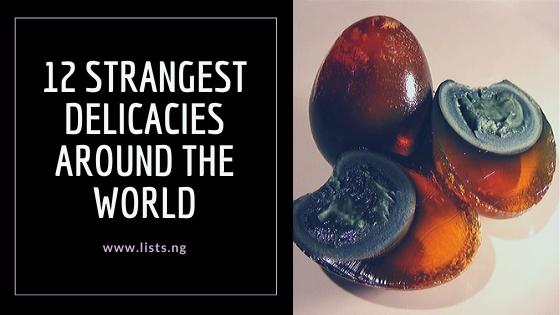When God created the world, he gave the first man the permission to do what he pleases with all he created minus the tree of good and evil. In other words humans are free to consume whatever the earth produces and several people and societies have gladly obliged, turning the strangest and most dangerous things into tasty delicacies (at least to them). Things that will normally make you gag at just the sight have been made enjoyable staples.
So, from killer fishes to fermented sharks, here are 12 strangest delicacies consumed all around the world.
1. Fugu

The Japanese delicacy fugu, or blowfish, is so poisonous that the smallest mistake in its preparation could be fatal. The dish which combines luxury and high-stajkes gamble is served in paper-thin slices by expert chefs. The intestines, ovaries and liver of fugu contain a poison called tetrodotoxin, which is 1,200 times deadlier than cyanide, hence, chefs must undergo two to three years of training to obtain a fugu-preparing license. Despite the risks, about 40 kinds of fugu are caught in Japan, and people consume 10,000 tons of the fish every year. A fugu dish attracts a $200 price tag.
2. Ackee

The ackee fruit originally native to West Africa, but since its migration to Jamaica in 1778 it has become the country’s national fruit, and frequently combined with codfish. Despite its national fruit status, if improperly eaten or prepared, ackee can cause what has been called the Jamaican Vomiting Sickness which can lead to coma or death. Unripe ackee fruit contains a poison called hypoglycin contains poisonous chemicals that can harm the liver also cause severely low blood sugar levels, convulsions, and death. Hence, before consumption, it is advisable to wait until the fruit’s protective pods turn red and open naturally. Once open, the only edible portion is the yellow arilli, which surround always-toxic black seeds.
3. Cobra blood

Despite the general consensus that snakes are dangerous, especially the Cobra, in many many places around the world, cobra blood is widely consumed. As a matter of fact it has been known to cure several diseases and illnesses such as liver diseases, asthma, impotence in men among others.
4. Balut

Balut is a developing bird embryo that is boiled and eaten from the shell. It is commonly sold as street food in the Philippines. The length of incubation before the egg is cooked is a matter of local preference, but generally ranges between 14 and 21 days. The broth taste like chicken soup, the embryo like liver, the yolk is creamy and the delicacy is usually enjoyed with beer.
5. Century eggs

Century eggs, also known as preserved egg is a Chinese preserved food product and delicacy made by preserving duck, chicken or quail eggs in a mixture of clay, ash, salt, quicklime, and rice hulls for several weeks to several months, depending on the method of processing. Through the process, the yolk becomes a dark green to grey color, with a creamy consistency and strong flavor due to the hydrogen sulfide and ammonia present, while the white becomes a dark brown, translucent jelly with a salty flavor.
6. Casu marzu

Casu marzu, also called casu modde or rotten cheese is a traditional Sardinian sheep milk cheese that contains live maggots. These larvae are deliberately introduced to the cheese, promoting an advanced level of fermentation and breaking down of the cheese’s fats. The texture of the cheese becomes very soft, with some liquid seeping out. Despite it being part of the Sardinian food heritage, it is illegal as it is classified as one of the most dangerous foods in the world.
7. Hákarl

Hákarl, also known as fermented sharks, is a national dish of Iceland consisting of a Greenland shark or other sleeper shark which has been cured with a particular fermentation process and hung to dry for four to five months. They contain a large amount of ammonia and has a strong smell, similar to many cleaning products. Those eating it for the first time are advised to pinch their nose because of the strong smell. It is often eaten with a shot of the local spirit, a type of akvavit called brennivín.
8. Bugs

While many of us might find this repulsive, bugs like cricket, termite, ants, worms and grasshoppers are consumed in many parts of the world and they have even been described as crunchy, yummy, delectable and highly nutritious. Some bug dishes you should try when you travel around the world include caterpillar fungus tea, locust flatbreads, mealworm spaghetti and vegetable curry with ant eggs.
9. Şırdan

Şırdan is a Turkish delicacy made with one of the 4 compartments of the sheep stomach. The Sheep’s stomach is stuffed with minced meat ,rice ,onion ,cummin and seasonings, then stitched together.
10. Frog legs

Frog legs are one of the better-known delicacies of French and Chinese cuisine but can also be found in other parts of the world. Frog legs are rich in protein, omega-3 fatty acids, vitamin A and potassium. They are often said to taste like chicken because of their mild flavor, with a texture most similar to chicken wings. The taste and texture of frog meat is approximately between chicken and fish.
11. Snake & Scorpion whiskey

This is one of the rearrest, most exotic and forbidden alcoholic pleasures. It is made by infusing a real farm raised Cobra snake, black scorpion, ginseng roots and herbal seed pods and then steeped for several months, which then imparts a unique flavour into the whiskey. The story is that this is used in South East Asia as a very strong Aphrodisiac; and it also has many medical uses, such as the treatment of back and muscle pain.
12. Edible bird’s nests

Edible bird’s nests are bird nests created by edible-nest swiftlets using solidified saliva, which are harvested for human consumption. They are particularly prized in Chinese culture due to their rarity, high nutritional value in nutrients such as protein, and rich flavor. Edible bird’s nests are among the most expensive animal products consumed by humans, with nests being sold at prices up to about $3,000 per pound ($6,600/kg), depending on grading. The Chinese believe that it promotes good health, especially for the skin.
Inspired by @reminola’s thread on twitter



